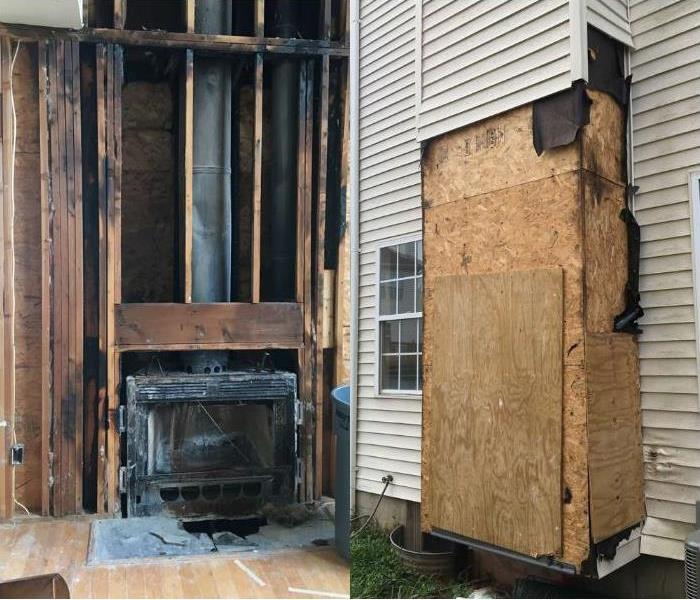Chimney Fire Guide: Causes, Signs & Prevention
10/14/2020 (Permalink)
When you burn a fire in your wood stove or fireplace during the winter months, soot, debris, or creosote builds up naturally over time. Although this buildup is natural, it is commonly what causes chimney fires. To help prevent a flue fire in your home this winter season we will review the causes, prevention, and signs of a chimney fire.
Chimney Fire Causes
The main cause of a chimney fire is creosote buildup igniting. Creosote is the residue that sticks to the inner walls of the chimney from the burning fire. Creosote is black or brown, tar-like, sticky, and is highly flammable. When enough builds up in the chimney flue it can easily catch fire from a spark.
How does creosote buildup?
- Restricted air supply - If the air supply of the fireplace is restricted by glass doors or the damper not being opened wide enough, heated smoke will not be able to rapidly move up and out of the chimney. The longer smoke is in the flue, the more likely it is to leave creosote residue behind.
- Burning unseasoned or the wrong firewood - Fresh cut wood is high in moisture and produces dense black smoke when burned. Firewood seasoned for at least 6 months produces less smoke. Artificial logs also produce more byproducts when combusting, increasing creosote buildup.
- Cool flue temperatures - A cold flue creates more condensation, allowing for creosote to more easily build up. Warm the flue before starting a fire if it is not well insulated.
Neglecting to take steps to clean your chimney or not taking steps to reduce the amount of creosote buildup increases your likelihood of a chimney fire occurring in your home.
Signs You're Having A Chimney Fire
A chimney fire can be fast burning or slow burning and both are dangerous.
Fast burning fires are obvious, growing as they burn at high temperatures through the flammable creosote in the flue. Signs you are having an active, fast burning chimney fire are:
- Loud crackling or popping noises
- Dense smoke coming down into the fireplace or out of the chimney
- Flames coming out of the chimney
- Things on fire or flames dropping down into the fireplace from the chimney
- Strong, hot smell
- Many report a 'roaring' sound, like a freight train
If you identify any of these while burning a fire, call 911 and evacuate your home immediately.
Slow burning fires are those that you don't realize are happening in your chimney. They're small enough to not give any signs in the moment they're burning, but they still damage the chimney and cause the fire to spread inside your home. These happen when flammable buildup on the sides of the chimney flue are hot enough to catch fire, but don't have enough fuel to become larger and noticeable. Signs your chimney has experienced a slow burning fire are:
- Fluffy or ashy creosote. Creosote is usually flat and black
- Damaged flue tiles
- Heat damaged structure on the roof
- Finding chunks of creosote outside or in the fireplace
- Cracks in the exterior of the chimney
- Seeing smoke escape through the sides of the chimney
All of these damages are cause by the heat of the slow burning fire in the flue. Many of these signs can only be identified by internal inspection - but only shows another reason to have a professional chimney sweep come and inspect your chimney once a year.
Preventing Chimney Fires
- Have your chimney inspected and cleaned once a year. If you heavily use it year round, you may need more cleanings. Consult with your chimney sweep to see what they recommend for you.
- Only burn 'clean' fires. Use seasoned wood to burn a fire that produces less smoke and in turn helps prevent buildup.
- Make sure the damper is fully open to prevent restricted air flow.
- Avoid putting paper on top of a fire and instead put it under the grate. When you put paper products on top of the fire, burning fragments can rise up the chimney and light the creosote on fire.
What Can You Do After A Chimney Fire?
Once the fire department has left and the flames have gone out, your home is likely left with a large amount of fire, structural, and smoke damage. You should contact your insurance company to see if your damages are covered, and then contact your local fire damage restoration company to come out and inspect your damages. SERVPRO of Morristown is fire damage restoration company with an in-house construction company - So we can handle your fire from cleanup to rebuild.



 24/7 Emergency Service
24/7 Emergency Service
